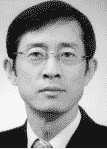CASE REPORT
Mandibular Molar Intrusion with Miniscrew Anchorage
Adult patients commonly present with one or more molars that have extruded into edentulous areas of the opposing arches. Adequate prosthodontic restorations may be difficult to place without first intruding the molars. Until the development of skeletal anchorage,1 this was virtually impossible in cases with insufficient remaining anchorage units, such as periodontally compromised patients--especially when the extruded molars were in the lower arch.
The following case shows effective mandibular molar intrusion using miniscrew anchorage.
Case Report
A 67-year-old female patient presented with missing maxillary left molars (Fig. 1). Due to extrusion of the mandibular left first and second molars, there was insufficient space for prosthodontic replacements.
Similar articles from the archive:

Fig. 1 67-year-old female patient with missing maxillary left molars and extruded mandibular left molars.
We inserted two miniscrews*, 1.3mm in diameter and 8mm in length, between the roots of the mandibular left first and second molars, one on the buccal side and the other on the lingual. A straight .036" stainless steel wire was bonded to the occlusal surfaces of both molars (Fig. 2). The composite was made thicker on the first molar surface so that the second molar would be intruded a little more.

Fig. 2 Application of intrusive force from elastic stretched between buccal and lingual miniscrews.
Because the patient lived far from the clinic, we opted to give her elastics instead of using power chain or elastic thread for application of the orthodontic force. Each 1/4", 5oz elastic was attached between the two miniscrews, crossing over the bonded wire to apply an intrusive force. The patient was given a wire handle and instructed to change the elastic once a day.
Six months later (Fig. 3), the molars had been intruded enough to allow implant restorations of the maxillary molars (Fig. 4).

Fig. 3 Patient after six months of mandibular molar intrusion.

Fig. 4 Implant restorations of maxillary left molars.
Conclusion
With miniscrew anchorage, molar intrusion is no longer one of the most difficult tooth movements in orthodontics, as illustrated in this patient. The miniscrew is small enough to be placed between the roots without any detrimental root contact during the intrusion, yet strong enough to provide effective skeletal anchorage.
FOOTNOTES
- *Absoanchor, Part No. SH 1312-08, Dentos, Inc., Daegu, Korea; www.dentos.co.kr.
REFERENCES
- 1. Kyung, H.M.; Park, H.S.; Bae, S.M.; Sung, J.H.; and Kim, I.B.: Development of orthodontic micro-implants for intraoral anchorage, J. Clin. Orthod. 37:321-328, 2003.



